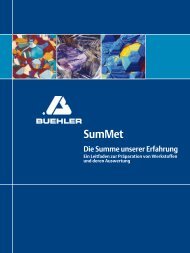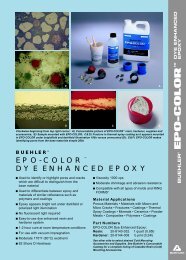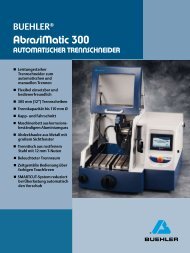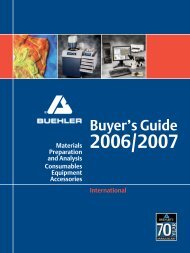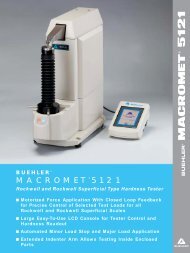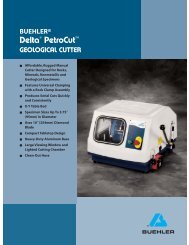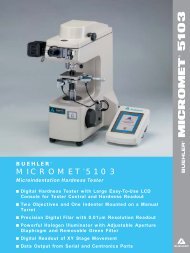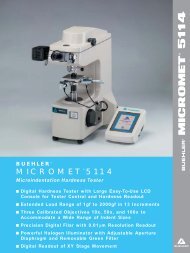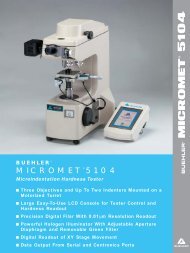Create successful ePaper yourself
Turn your PDF publications into a flip-book with our unique Google optimized e-Paper software.
4. Castable (Cold) Mounting Compounds (continued)<br />
Product Curing Time Transparency<br />
VariDur 10 < 10 min<br />
Selection Criteria for Cold Mounting Compounds<br />
Semi<br />
transparent<br />
Vacuum<br />
Impregnation<br />
Edge Retention Specific Applications<br />
� Routine<br />
VariDur 200 < 10 min � � �� Routine<br />
VariDur 3000 10 min � � ��� Edge investigation<br />
VariKleer < 10 min Transparent* � PCB<br />
SamplKwick < 10 min<br />
Semi<br />
transparent<br />
VariKwick 5 min � �<br />
� PCB<br />
EpoxiCure < 8 h Transparent � � < HV400<br />
EpoxiCure NC < 5 h Transparent � � < HV400<br />
EpoKwick < 2 h Transparent � � < HV400 Quick cure<br />
EpoHeat < 2 h @ 55° C Transparent ��� � < HV400 Quick cure<br />
EpoThin < 9 h Transparent ��� � < HV400 Petrography<br />
EpoColor < 2 h � � � < HV400<br />
EpoPlast < 8 h Transparent � � < HV400<br />
Colour contrast of pores<br />
& cracks in DF<br />
Technovit 5000 < 10 min � � SEM, electrolytic polishing<br />
Cold Mounting<br />
Pressure vessel<br />
Cast N‘ Vac<br />
Cast N‘ Vac 1000<br />
* in combination with compression hardening in a pressure pot<br />
��� Very Good �� Good � Average � Not suitable<br />
The main advantage of cold mounting is the ability to mount specimens of<br />
irregular shape and size. It is often favoured for embedding individual<br />
samples, when the acquisition of a mounting press is not economically<br />
justifiable. Conversely, it is helpful for mounting large numbers of samples as<br />
quickly as possible.<br />
Cold mounting products fall into one of three categories: acrylics, polyesters<br />
and epoxies. They may consist of two or more components that need to be<br />
mixed together to make a solid cured specimen. Epoxide compounds exhibit<br />
the lowest contraction. The long curing time gives outstanding edge<br />
retention and very low shrinkage, and is chemically resistant. Acrylics have a<br />
short curing time and have a small amount of contraction that can be<br />
improved with fillers and curing under pressure in a pressure vessel. With<br />
polyester resins the curing times are relatively short, but often produce a poor<br />
quality mount and are only used due to low cost.<br />
After mixing the components, the hardening process takes place via an<br />
exothermic reaction. During curing, particularly with acrylics, this hardening<br />
process can generate over 80°C, and one must be careful when working with<br />
temperature-sensitive materials, e.g. plastics, where the structure of the<br />
sample can be affected.<br />
Vacuum Impregnation:<br />
Porous materials, e.g. ceramic(s) or sprayed coatings should be vacuum<br />
impregnated with epoxy resin prior to sectioning. The porous or friable<br />
ceramic is strengthened and protected by the epoxy resin. Cavities, pores and<br />
cracks that are open to the surface are filled with the embedding material. For<br />
high contrast definition of pores and cracks, we offer Epo-Color resin which,<br />
under dark field lighting, appears a vivid red colour and thus makes the<br />
interpretation of the structure easier.<br />
MOUNTING<br />
21



